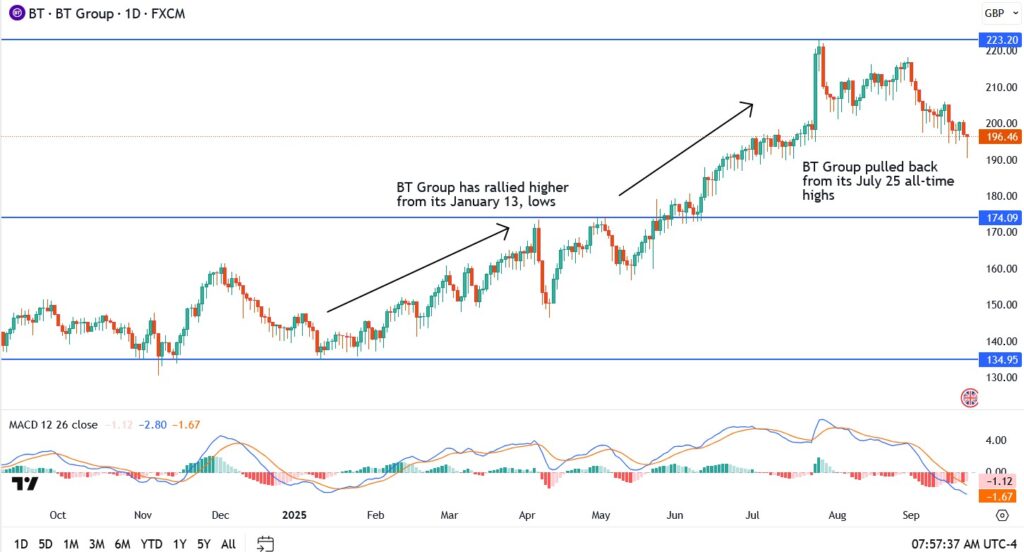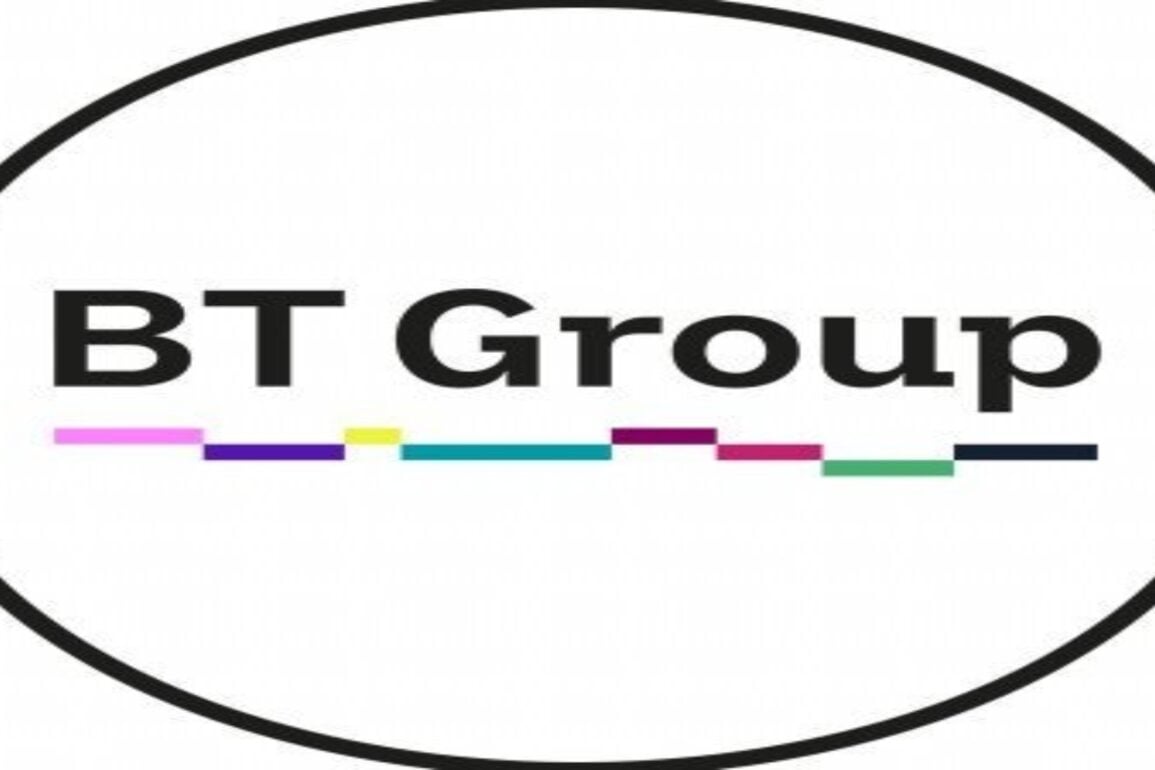- BT shares climb as investors back fibre rollout progress, debt reduction and 4% dividend yield. Analysts set targets around 210p.
BT Group Share Price Analysis: Momentum and Resistance
BT Group (LON: BT.A) has quietly staged an impressive rally. From the January trough near 135p, shares climbed to 223p by July, marking multi-year highs. The move has since cooled, with the stock consolidating around 195-200p.
The chart remains constructive. Support is clearly defined near 174p, where buyers stepped in earlier this year. Resistance is firm at 223p, the ceiling that triggered profit-taking. Momentum indicators such as the MACD show signs of fatigue, suggesting consolidation before the next leg higher. For me, this doesn’t look like a “one-off bounce” but part of a larger trend change, a signal that the market is beginning to recognise a leaner, more focused BT.

BT Group Turnaround 2025: Fibre Rollout Progress and Cost Discipline
CEO Allison Kirkby has put the turnaround in motion. Her playbook is blunt but necessary: simplify the structure, reduce debt, and extract efficiencies. The sale of non-core assets, including the global enterprise unit Etc., was not just about raising more than £600 million, it was about sharpening the company’s focus on its UK heartland and easing its pension burden.
I personally think this kind of deleveraging is the foundation of the BT re-rating story. A lighter balance sheet means less defensive firefighting and more scope to allocate capital toward growth and shareholder returns.
BT Group Dividend Forecast: Yield and Payout Outlook
For many investors, the attraction is straightforward: yield. At roughly 4%, BT’s dividend already outpaces many FTSE peers. But the real prize lies ahead. Once the fibre build-out matures, capex will ease, and the cash flow dynamic will change dramatically. That opens the door to meaningful dividend growth.
I see today’s yield as a floor, not a ceiling. If debt targets are met, dividend hikes could become a central theme of BT’s investment case over the next three to five years, turning this into a classic income-plus-growth stock.
BT Group’s Openreach Fibre Rollout and Growth Outlook
Openreach, the infrastructure division, remains BT’s most valuable asset. The full-fibre rollout is expensive and complex, but the long-term economics are powerful. As more households and businesses connect, Openreach evolves from a capital-intensive builder into a margin-rich cash generator. Every new line is recurring, inflation-linked revenue.
Investors haven’t ignored the possibility of external partnerships or even a partial spin-off. Such a move could crystallise billions of pounds in hidden value. While not imminent, it remains one of the most compelling optionalities in BT’s long-term story.
Is BT Group Stock a Buy in 2025? Analyst Outlook
The risks are clear: execution delays in fibre, rising competition, and the ever-present pension deficit. Yet the upside is equally visible. The combination of debt reduction, cost discipline, and a maturing fibre business is changing the narrative. Add a reliable dividend, and you have a stock that blends defensive qualities with tangible growth drivers.
I personally believe BT is moving from being a perennial underperformer to a credible re-rating candidate. For patient investors, this could be the first real wake-up call for a stock that has been asleep for too long.
BT Group Stock FAQs
BT shares are rising on several fronts: the company appears to have passed peak spending on its full-fibre rollout, reducing capital expenditure pressures. Investors are encouraged by strong cost-cutting initiatives, better cash flow, and clearer strategic focus under current leadership. Another catalyst is that major shareholders have pushed for greater oversight, lending confidence there will be disciplined execution.
Most analysts see BT’s 12-month share price target in the ballpark of 205-215 pence, with more bullish forecasts reaching 286 pence and the lower bound around 135-140 pence. The median target is roughly 210 pence, which implies modest upside from current levels.
It depends on your time horizon. In the short term, some think BT is near fair or slightly overvalued given how much of the “easy upside” seems factored in. But if you believe in the turnaround, debt reduction, fibre revenue ramp, cost discipline, the price could still rise meaningfully. In other words, value is there, but risk is also elevated until execution proves consistent.
Yes, BT still pays dividends, with a trailing yield of about 3.9-4.1%. The yield is supported by earnings and cash flow, though the payout ratio is fairly high, meaning there is less margin for error. If fibre capex declines as expected and debt is managed well, the dividend looks sustainable and even likely to grow.


